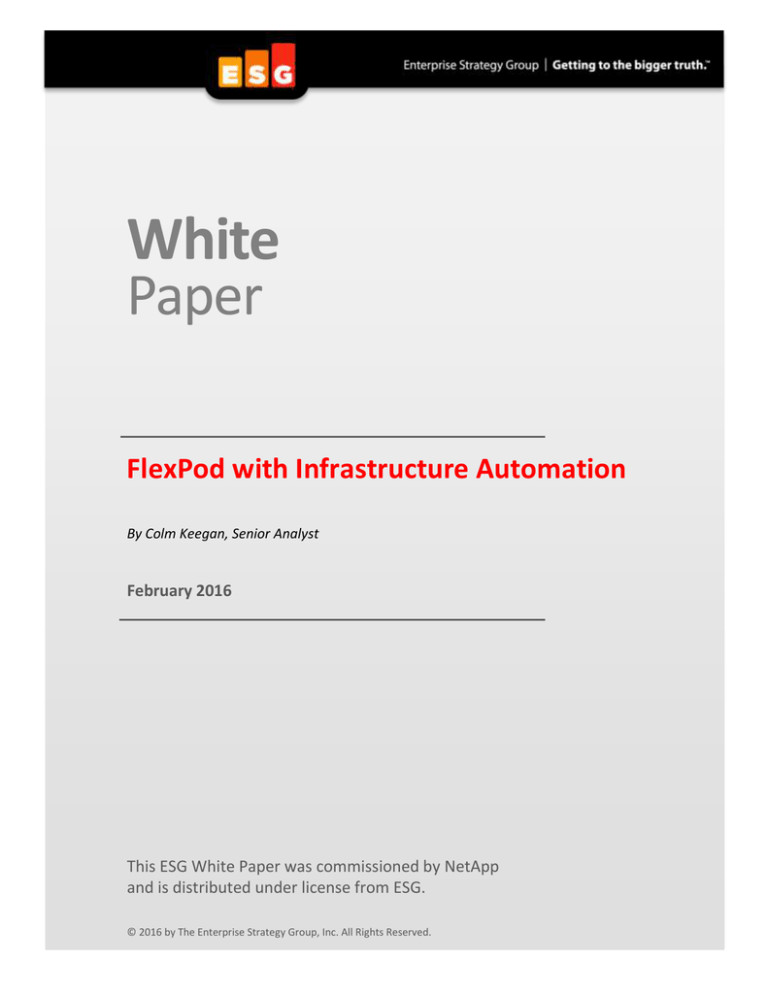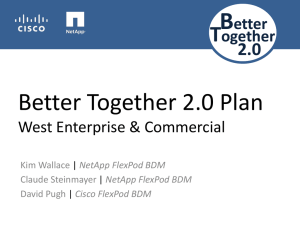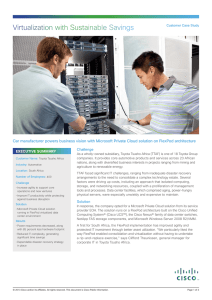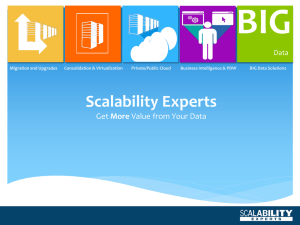White Paper FlexPod with Infrastructure Automation
advertisement

White Paper FlexPod with Infrastructure Automation By Colm Keegan, Senior Analyst February 2016 This ESG White Paper was commissioned by NetApp and is distributed under license from ESG. © 2016 by The Enterprise Strategy Group, Inc. All Rights Reserved. White Paper: FlexPod with Infrastructure Automation 2 Contents Business Demand for Converged Infrastructure .......................................................................................... 3 FlexPod with Infrastructure Automation.................................................................................................................. 4 Data Security and Data Protection: Top of Mind Concerns ..................................................................................... 5 FlexPod Delivers Ease of Deployment, Ease of Acquisition, and Ease of Management .......................................... 8 The Bigger Truth ........................................................................................................................................... 9 All trademark names are property of their respective companies. Information contained in this publication has been obtained by sources The Enterprise Strategy Group (ESG) considers to be reliable but is not warranted by ESG. This publication may contain opinions of ESG, which are subject to change from time to time. This publication is copyrighted by The Enterprise Strategy Group, Inc. Any reproduction or redistribution of this publication, in whole or in part, whether in hard-copy format, electronically, or otherwise to persons not authorized to receive it, without the express consent of The Enterprise Strategy Group, Inc., is in violation of U.S. copyright law and will be subject to an action for civil damages and, if applicable, criminal prosecution. Should you have any questions, please contact ESG Client Relations at 508.482.0188. © 2016 by The Enterprise Strategy Group, Inc. All Rights Reserved. White Paper: FlexPod with Infrastructure Automation 3 Business Demand for Converged Infrastructure Converged infrastructure solutions continue to be embraced by businesses of all sizes. When examining the principal factors for the ongoing demand in converged infrastructure (CI) systems (referred to as integrated computing platforms by ESG), ESG research has found that three of the top benefits that organizations reported from their deployment of integrated computing platforms are speed of deployment, improved service and support, and ease of management. Improved TCO and improved scalability were also near the top of the list of reported benefits (see Figure 1).1 Figure 1. Benefits Realized by Deploying Integrated Computing Platforms What benefits has your organization realized by deploying integrated computing platforms? (Percent of respondents, N=99, multiple responses accepted) Faster deployment time 53% Improved service and support 52% Ease of management 51% Simplified deployment process 44% Improved total cost of ownership (TCO) 43% Improved scalability 42% Increased agility of virtual machine provisioning 41% Less time and resources required for hardware and/or software integration 41% Reduction in interoperability issues 29% More predictable costs when scaling 29% Ease of acquisition 27% Less training required 26% 0% 10% 20% 30% 40% 50% 60% Source: Enterprise Strategy Group, 2016. An example of a converged infrastructure (CI) solution offering is the FlexPod platform, a joint offering from Cisco and NetApp. In the past five years, over 7,000 organizations have implemented FlexPod across more than 100 countries. As a pre-integrated rack of virtualized server compute, storage, and networking resources, FlexPod enables organizations to rapidly deploy virtualized infrastructure into their data center environments. Moreover, since the entire solution is supported by a single services organization, IT administrators only have to make one call to receive service and support. Likewise, ongoing management is greatly simplified, as virtual machines can be quickly provisioned with a few clicks of a mouse, enabling IT to be more responsive to their internal clients. The success of CI in the data center has driven interest to deploy CI in other areas throughout the enterprise where simplified infrastructure deployments can add further value. Remote offices and small data center environments, for example, are excellent candidates for CI. In fact, ESG research surveyed over 300 IT professionals and learned 1 Source: ESG Research Report, Trends in Private Cloud Infrastructure, April 2014. © 2016 by The Enterprise Strategy Group, Inc. All Rights Reserved. White Paper: FlexPod with Infrastructure Automation 4 that organizations supporting remote office/branch office (ROBO) locations are interested in CI to simplify deployments, enable better service and support, enhance availability, and simplify ongoing management. Furthermore, nearly half of the respondents (47%) indicated that ease of acquisition led them to deploy or consider an ICP (see Figure 2).2 Figure 2. Drivers for Deploying Integrated Computing Platform(s) at ROBO Locations Which of the following factors drove your organization’s deployment – or consideration – of an integrated computing platform(s) at ROBO locations? What would you say was the primary reason that you deployed – or are considering deploying – an integrated computing platform(s) at ROBO locations? (Percent of respondents, N=322) 10% Ease of deployment 53% 13% Achieve better availability and resiliency 52% 15% Improved service and support 51% 10% Reduce physical on-premises IT footprint 48% 13% Simplify ongoing management 47% 11% Ease of acquisition Speed up deployment 9% Reduce local support 9% 47% 45% 43% 3% Existing vendor relationship All reasons for deploying integrated computing platform(s) at ROBO locations 47% 6% Reduction in interoperability issues Primary reason for deploying integrated computing platform(s) at ROBO locations 36% 1% 1% Don't know 0% 10% 20% 30% 40% 50% 60% Source: Enterprise Strategy Group, 2016. The challenge, however, is that CI has typically only been affordable in larger data center environments that service dozens or hundreds of applications. But the reality is that the same operational challenges and complexities that exist in primary or large data centers also exist in remote office and small data center environments. To address the demand for affordable CI systems in edge locations, NetApp has partnered with Cisco to deliver FlexPod with Infrastructure Automation. FlexPod with Infrastructure Automation This new offering provides remote office locations and small data centers a FlexPod CI solution with all the same native features/functionality that are available in FlexPod platforms installed in large data center environments. The key difference is that the FlexPod is designed specifically to meet the operational simplicity requirements of ROBO and small data center environments. The new FlexPod is a pre-integrated CI solution that combines a new Cisco UCS “Mini” server computing blade with a Cisco Nexus 9000 switch, a NetApp FAS 2552 filer configured with Data ONTAP version 8.3, and VMware's vSphere hypervisor software technology. UCS Mini Cisco UCS Mini is ideal for remote and branch offices and small data centers that need fewer servers but still want the comprehensive management capabilities provided by UCS Manager. UCS Mini delivers servers, storage, and 10 Gigabit networking in an easy to deploy, compact form factor. FlexPod with infrastructure automation leverages 2 Source: ESG Research Report, Remote Office/Branch Office Technology Trends, May 2015. © 2016 by The Enterprise Strategy Group, Inc. All Rights Reserved. White Paper: FlexPod with Infrastructure Automation 5 UCS Mini to radically simplify the ordering, delivery, and installation processes so that solutions can be deployed easily and quickly. This solution is designed to be ordered and delivered in just days and go from power-up to VM deployments in under 60 minutes. After the solution is up and running, the enhanced management experience, scalability, and worldwide support make it easy and cost effective to own, which is especially important in edge and branch offices as there is often a lack of skilled IT administrators in these locations. Leveraging FlexPod from the data center to the edge helps prevent islands of IT infrastructure with the use of common tools and processes to simplify management and support. In addition to simplified point-and-click management, the FlexPod architecture also consists of advanced softwaredefined networking (SDN) capabilities via a non-blocking, 10G/40G Ethernet Nexus 9000 switch. Configured with Cisco’s application centric infrastructure (ACI) software, administrators can optionally prioritize access to virtualized resources (compute, network, storage) based on the criticality of the underlying business application. This helps to ensure quality of service (QoS) for key business applications without the need for manual intervention. Data Security and Data Protection: Top of Mind Concerns Data security and data protection continue to rank as key concerns for businesses that have remote offices and small data center environments to support (see Figure 3).3 The FlexPod helps address both of these key concerns through native data protection and data security features. The FlexPod provides unified data management via Clustered Data ONTAP version 8.3. This intelligent file system software supports native data protection capabilities via point-in-time snapshots that allow corrupted or accidentally deleted files or user directories to be instantly restored. When combined with NetApp’s SnapVault software, businesses can mirror or replicate critical data sets back to a primary data center for offsite DR protection or alternatively, in the cloud, to an AWS instance. This flexibility helps organizations of all sizes to implement a DR plan that is both affordable and in-line with the availability and service level requirements of their key business applications. Figure 3. Top Five IT Priorities with Respect to Supporting ROBO Locations Which of the following would you consider to be your organization’s top IT priorities with respect to supporting ROBO locations? (Percent of respondents, N=347, seven responses accepted) Improving information security measures 45% Improving application performance for end-users 41% Managing data growth 37% Improving backup and recovery processes 37% Improving employees’ abilities to share files/collaborate with other employees 36% 0% 5% 10% 15% 20% 25% 30% 35% 40% 45% 50% Source: Enterprise Strategy Group, 2016. 3 Source: ibid. © 2016 by The Enterprise Strategy Group, Inc. All Rights Reserved. White Paper: FlexPod with Infrastructure Automation 6 End-to-end Data Encryption Data security is a top-of-mind issue for business and IT executives alike. Case in point, for the last four years in a row, security has topped the list of respondents’ most-cited IT priorities in ESG’s annual IT spending intentions survey.4 Data security is maintained at all times on the FlexPod Mini via data encryption for data in flight (data that traverses the corporate WAN and cloud) as well as encryption for data at rest (stored on NetApp disk volumes). And only FlexPod administrators have access to the data encryption keys, helping to minimize the risk of data theft by internal or external sources. Converged Infrastructure Use Cases Given the ease of deployment, ease of management, greater agility, and lower TCO benefits that organizations are realizing through the use of CI in the primary data center, many IT planners are now looking to extend their use of CI in other locations throughout the enterprise. As previously discussed, remote office and edge locations often have many of the same day-to-day infrastructure management challenges that exist in large data center environments. And despite the infrastructure consolidation efforts of the past decade, many businesses still support a heavy complement of local applications across their branch office locations. According to ESG research, for example, of 347 IT professionals surveyed, 29% indicated that they currently support between 11 and 25 physical servers in their typical ROBO locations, with an additional 30% reporting that they support over 25 servers in these offices (see Figure 4).5 Figure 4. Number of Physical Servers at the Typical ROBO Location On average, approximately how many physical servers are deployed at the typical ROBO location supported by your organization? (Percent of respondents, N=347) 35% 29% 30% 25% 24% 20% 20% 17% 15% 10% 10% 5% 1% 0% 1 to 5 6 to 10 11 to 25 26 to 50 More than 50 Don’t know Source: Enterprise Strategy Group, 2016. Furthermore, many organizations have implemented or are planning to implement server virtualization in their ROBO office locations to reduce server footprint, simplify server management, and speed up application delivery (see Figure 5).6 4 Source: ESG Research Report, 2015 IT Spending Intentions Survey, February 2015. Source: ESG Research Report, Remote Office/Branch Office Technology Trends, May 2015. 6 Source: ibid. 5 © 2016 by The Enterprise Strategy Group, Inc. All Rights Reserved. White Paper: FlexPod with Infrastructure Automation 7 Figure 5. Usage of Server Virtualization Technology at ROBO Locations Is server virtualization technology deployed at any of your organization’s ROBO locations? (Percent of respondents, N=347) No, and we have no current plans to implement it at any of our ROBO locations, 9% No, but there are plans to implement it at a limited number our ROBO locations, 14% Don’t know, 1% Yes, 52% No, but there are plans to implement it at many of our ROBO locations, 25% Source: Enterprise Strategy Group, 2016. While this is an important step toward improving operational efficiencies, it still requires either local administrators to manage the environment and/or support from IT personnel in the central data center location. The challenge is that local IT skillsets are often not available in the branch, which means that central IT staff typically have to take ownership of managing and provisioning virtual servers, configuring and tuning storage, and backing up data, etc. This adds more management overhead to already overburdened IT staff. The FlexPod is an ideal way for businesses to consolidate this application infrastructure while greatly simplifying management of the entire environment. For example, the UCS server integrated into the FlexPod provides a single point of management for all the virtualized hosts in the branch office. Virtual servers can be quickly provisioned with point-and-click simplicity, enabling IT admins with rudimentary skills to manage the environment. This can potentially allow branch office locations to be more self-sufficient and remove the onus on central IT to respond to every application configuration change or request. VDI Many ROBO locations are implementing virtual desktop infrastructure (VDI) as a way to further simplify infrastructure management, improve security, and enhance data protection. To spur VDI adoption, however, it is critically important that end-users get the same performance and experience from virtualized desktops as they do from physical desktop systems. Consequently, businesses need solutions that are specifically designed with VDI in mind. FlexPod is optimized for VDI workloads to help ensure a strong end-user experience and a successful VDI implementation. Moreover, FlexPod provides the scalability required to support ongoing VDI growth. © 2016 by The Enterprise Strategy Group, Inc. All Rights Reserved. White Paper: FlexPod with Infrastructure Automation 8 FlexPod Delivers Ease of Deployment, Ease of Acquisition, and Ease of Management As previously discussed, many IT planners are looking for remote office infrastructure solutions that are easy to deploy, easy to acquire, and easy to manage. Built as a standardized, pre-integrated solution that is fully cabled inside a 24U rack, the new FlexPod offering ships in a 5-10 day timeframe, from point of order, to help organizations rapidly accelerate virtualized infrastructure deployments into their edge locations. All the required hardware and software componentry is self-contained within the FlexPod rack (UCS server compute, Nexus 9000 switch, Network Appliance FAS 2552 filer, and VMware vSphere hypervisor software). This helps to greatly simplify the infrastructure acquisition process while reducing the time it takes to deploy and provision virtualized business applications. Since FlexPod drives increased levels of automation and orchestration, businesses can ease the day-to-day management of virtualized infrastructure in their branch and remote office locations. In fact, 51% of respondents to an ESG survey reported that ease of management was one of the top benefits realized through their deployment of integrated computing platforms (CI).7 Through its intuitive, point-and-click UCS management interfaces, a FlexPod solution can help organizations speed up the learning curve for managing virtualized server environments. Single Point of Contact for Support As importantly, FlexPod can provide vastly improved service and support since the entire CI stack is supported through one services organization. Businesses can contract support on their FlexPod systems through several options. They can choose to have their existing value-added premium reseller provide support, contract with a FlexPod distribution partner, or have Network Appliance or Cisco support the environment. Whatever the chosen option, through one phone call, businesses can get end-to-end service and support on their FlexPod systems. 7 Source: ESG Research Report, Trends in Private Cloud Infrastructure, April 2014. © 2016 by The Enterprise Strategy Group, Inc. All Rights Reserved. White Paper: FlexPod with Infrastructure Automation 9 The Bigger Truth Small data center and remote office locations often have many of the same IT infrastructure challenges that are common in larger data center environments: growing virtualized application environments, the need for improved data security and data protection, and the need to improve agility so that IT can move at the speed of business. But one of the fundamental problems for these edge locations is they typically don’t have the financial or IT personnel resources available to make the infrastructure changes required to achieve these objectives Converged infrastructure can be a vehicle to enable businesses of all sizes to drive operational efficiencies across the board—from rapid deployment of virtualized infrastructure resources through improved data security, data protection, and application quality of service to greatly simplified day-to-day management. The challenge, at least from a small data center and remote office standpoint, is deploying infrastructure simply and quickly to meet the new demands of the business. NetApp and Cisco’s new FlexPod offering is designed to simplify the ordering and deployment process while leveraging the management tools that they are already using in the data center. It provides the same infrastructure efficiencies, features/functionality, and operational benefits that the data center FlexPod platform has been providing to larger data centers over the last five years. Deployed as a pre-configured rack with no cabling or integration work required, the FlexPod can go from power-on to VM deployment in small data center and ROBO locations in under 60 minutes. As importantly, this system addresses the need for simplified management in edge locations, where IT resources may be limited, by providing an intuitive management interface with UCS Director for provisioning virtualized (compute, network, storage) application resources. This can help remote offices be more self-sufficient and responsive to the changing needs of the business while preventing the infrastructure silos and complexity that commonly arise when organizations use different technologies/platforms to meet their ROBO objectives. From a data security perspective, the FlexPod leverages data encryption for data in flight and at rest to help ensure the security of sensitive business data. And for data protection, the Clustered Data ONTAP operating system utilizes point-in-time snapshotting capabilities to protect data locally and, optionally, remotely through integration with NetApp’s SnapVault technology. In short, the features of the new NetApp and Cisco FlexPod with Infrastructure Automation offering provide small data centers and ROBOs with an affordable, easy to acquire and deploy, consolidated infrastructure solution that delivers the provisioning simplicity needed to enable business speed and agility. © 2016 by The Enterprise Strategy Group, Inc. All Rights Reserved. 20 Asylum Street | Milford, MA 01757 | Tel: 508.482.0188 Fax: 508.482.0218 | www.esg-global.com


